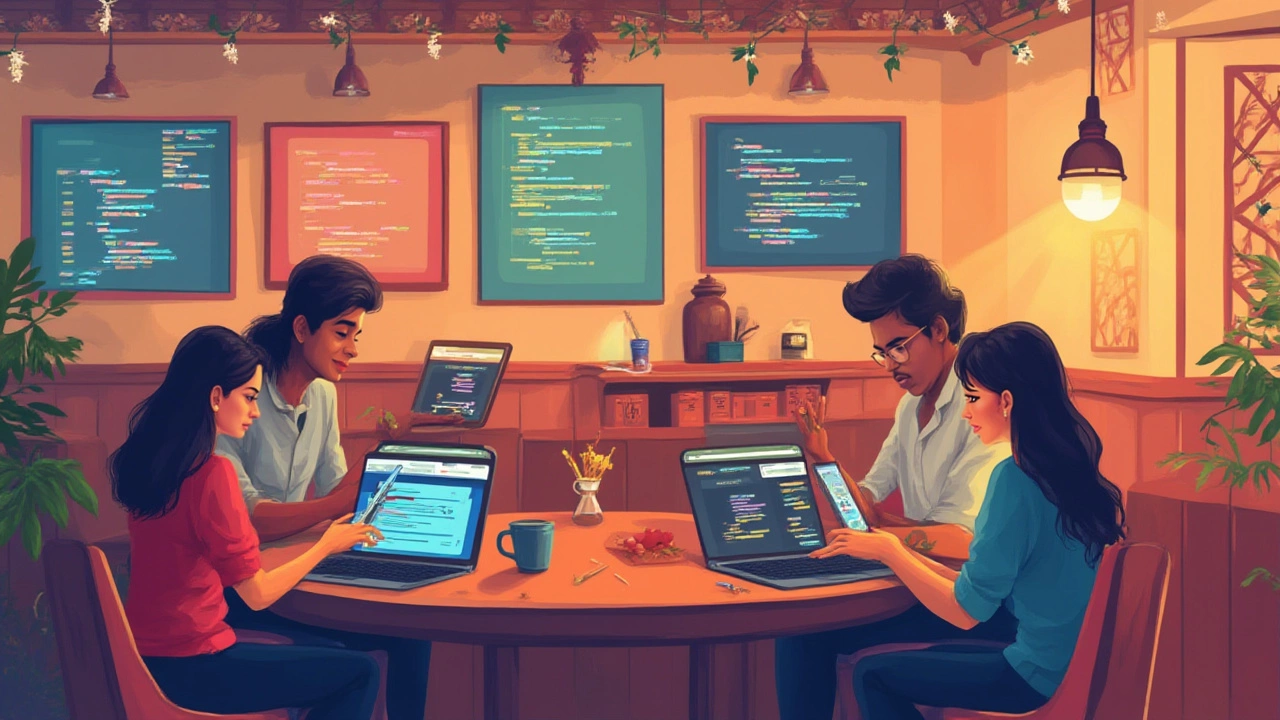
If you stop for a second and really look around, you’ll notice codes are basically everywhere. Street signs, QR codes on your favourite coffee, your computer software, the products in your supermarket—all packed with instructions or secrets that make things run, talk, or stay hidden. But not all codes are created equal. Some are meant to tell machines what to do, others are there for secret-keeping, and a few are simply clever ways to keep things organised. When people talk about “coding,” a lot of them picture folks hunched over computers. But in reality, there are 5 very different types of codes running the world. Want a peek behind the curtain?
Programming Codes: The Brains Behind Technology
Programming codes are like recipe books for computers. Imagine trying to get a stubborn robot to do what you want—it won’t budge unless you’re really specific. That’s where programming comes in. Using programming languages like Python, Java, or C++, we tell computers exactly what steps to take, line by line. Don’t worry if you’re not a software developer—the stuff under your phone's hood, traffic lights, ATMs, your microwave, all these things use some kind of code to work.
Here’s a fun fact: Python (probably the friendliest language out there) is behind Instagram, Spotify, and even the International Space Station’s control scripts. There are over 700 programming languages, but you only ever need to know a dozen to build almost anything in tech today.
Programming codes can be simple:
print('Hello, world!')
That’s the classic starter. Or wildly complex—think billion-dollar algorithms powering online banking or your favourite ride-sharing app.
Let’s not forget, there are different ways of writing programming code, known as paradigms. Some (like object-oriented) break everything into bite-size reusable blocks. Others (functional, procedural) prefer to handle things step-by-step or as mathematical functions.
Debugging—fixing mistakes in code—is a big part of the job. Nearly 75% of every developer’s time, according to a 2024 Stack Overflow survey, is spent checking and fixing errors, not just creating new features. There’s also version control, the practice of keeping track of every tiny edit so nothing breaks when you update the system.
Learning programming isn’t just for techies, either. In Australia, points for coding skills on job applications shot up 30% last year, as reported by SEEK. And in schools across Melbourne, coding is now part of many high school curriculums.
Here’s a neat little comparison of some popular programming languages:
| Language | Main Use | Learning Difficulty |
|---|---|---|
| Python | Web, Data Science | Easy |
| JavaScript | Web development | Moderate |
| Java | Android, Enterprise | Challenging |
| C++ | Games, Systems | Hard |
Pro tip: If you want to dip your toe in coding without getting overwhelmed, start with block-based environments like Scratch, or jump straight into Python using free resources like Codecademy or Khan Academy. And don’t sweat the mistakes—you’ll make hundreds, just like the pros.
Cipher Codes: Hiding Secrets, Sending Messages
If you’ve ever passed a note in class written in pig latin or swapped letters for numbers, congrats—you’ve used a cipher code. Ciphers are designed to hide meaning, and they’ve been around for thousands of years. Some of these old tricks are so clever, armies and spies relied on them to keep messages secret.
The ancient Greeks used the Scytale—a cylinder and a strip of parchment. During World War II, Enigma machines scrambled messages so well, it took the super brains at Bletchley Park (shout out to Alan Turing) and the early days of computers to break them.
Today’s ciphers live in your phone, keeping your texts and bank details private. Ever noticed a website with “https”? That ‘s’ stands for secure—thanks to encryption, which is just a modern cipher. And here’s a bit of trivia: The famous Caesar cipher, invented by Julius Caesar, just shifts letters by a set number (A becomes D, B becomes E, and so on). Sounds simple, but back in the day, it was practically unbreakable without the key.
- Substitution ciphers: Swap letters or numbers for something else. Think secret decoder rings from cereal boxes.
- Transposition ciphers: Mix up the order of letters. “HELLO” might become “EHLLO.”
- Modern encryption: Uses crazy math and computers. Take AES (Advanced Encryption Standard), which secures global banking.
And then there’s the art of cryptanalysis—the crack team of codebreakers working to uncover these hidden messages. Fun fact: During World War II, a single Enigma-encrypted message could take entire rooms of codebreakers weeks to solve, until the first digital computers kicked in.
What’s the big deal about ciphers today? They’re at the heart of online privacy. Each WhatsApp message, banking app transaction or even a cheeky DM is protected by encryption. If you’re the curious sort, try encrypting your own message using a simple tool like Boxentriq’s Caesar cipher online. Just don’t use it for your bank details!

Barcodes, QR Codes, and More: Codes You Can See and Scan
Ever wondered what those black-and-white stripes or dotted squares really mean on your shopping? Barcodes and QR codes are everywhere—from bags of rice at the Woolies till to festival tickets delivered to your phone. These visual codes carry data in a way computers instantly recognise, making stuff easier to track, count, ship, or access.
Here’s a quick breakdown of the most common codes you’ll see in the wild:
- Barcodes: Classic stripes found on supermarket items. A simple scan pulls up the price, product name, stock info. The world’s first item ever scanned at a checkout? A pack of Wrigley’s Juicy Fruit gum, back in 1974, Ohio.
- QR Codes: The next-gen barcode. They store way more info—instructions, URLs, payment links, or marketing offers. During the pandemic, QR codes became the go-to for menus and check-ins almost overnight here in Australia.
- Data Matrix & Other 2D Codes: Used on tiny items (like circuit boards or medicine packaging), these codes hold mountains of data in a small space. They don’t even need to be the right way up when scanning.
Why do these codes matter? For businesses, it’s about tracking and controlling supply—every scanned barcode zips into an inventory database. For consumers, it means speed and accuracy. No more mismatched prices or missing packages.
Check out this table with the most common visual codes and what makes them unique:
| Code Type | Looks Like | Main Uses | Capacity |
|---|---|---|---|
| Barcode | Parallel Lines | Retail, Inventory | 20-25 characters |
| QR Code | Square, Dots | Web links, Tickets | Up to 7,000 digits |
| Data Matrix | Square, Dense Dots | Medical, Electronics | Up to 2,335 alphanumeric |
If you want an easy way to make your own code (for a digital business card maybe), free online generators can whip up a custom QR code in seconds. And for fun, next time you’re in a store, look for the tiny code hidden alongside the main barcode—manufacturers often use these to trace where and when a batch was made.
Legal, Building, and Conduct Codes: Rules Locked in Words
Not all codes are made for computers or secret agents. “Code” sometimes just means a written set of rules—think building codes, legal statutes, or codes of conduct. In this sense, codes don’t hide meaning; they spell everything out (sometimes in painful detail).
Take building codes, for example. Here in Victoria, homes and offices must follow strict regulations so they’re safe, sturdy, and energy-efficient. The National Construction Code, updated each year, covers everything from fire safety to the minimum height of a staircase. Breaking the code? Risks fines, legal trouble, or losing your license.
Legal codes are pretty epic too—huge collections of rules and laws, like the Criminal Code Act 1995 down in Canberra. If you’re interested in law (or just love crime dramas), you’ve probably heard the phrase, “charged under Section X of the code.” That’s lawyers referring to the exact chapter of the statute book, no guesswork allowed.
Companies and schools have their own codes of conduct. These spell out what’s acceptable (no harassment, respect for others), which means everyone knows where they stand. Fun fact: in most top Aussie firms, breaking the code of conduct can mean instant dismissal, no debate.
Here’s an example table of the types of legal and regulatory codes:
| Code Type | Purpose | Where Used |
|---|---|---|
| Building Code | Safety rules | Construction, Architecture |
| Legal Code | Govt. laws | Courts, Police |
| Conduct Code | Behaviour rules | Schools, Companies |
If you want a copy of a building or conduct code, most are available for free online. For legal codes, the government websites are your best bet. And here’s a tip: if you’re ever renovating a house or starting a business, read the codes first. Far better than paying nasty fines down the track.

Coding Systems: Organising Chaos
Let’s talk about those codes you don’t always think about—systems for organising complex stuff so we can make sense of it. We’re talking model numbers, postal codes, medical codes, and even ISBNs on books.
Why do they exist? Imagine trying to sort a warehouse without some kind of code. Or sending a letter anywhere in Australia without a postcode. Chaos. These coding systems turn a mess into a working system—each code fits a specific pattern so it doesn’t get mixed up with another.
- Postcodes: Australia rolled out its current four-digit postcode system in 1967, making mail delivery a breeze. Melbourne postcodes start at 3000, and each suburb has its own unique number to keep things moving.
- ISBN Codes: Every book published globally gets a unique number. The ISBN (International Standard Book Number) was introduced in 1970 to cut through confusion as book publishing exploded.
- Model Numbers: From phones to microwaves to cars, every product line gets a model or batch code. For companies, this means easy recalls and repairs.
- Medical Codes: Healthcare runs on codes: doctors record diagnoses and treatments using ICD-10 or SNOMED codes, helping with billing, insurance, and research.
Coding systems are all about efficiency. If you’ve used Google Maps, you’ve seen the advantage—plugging in a postcode brings up the right suburb instantly. Or when you’ve searched for a fridge model online and found the exact manual without fuss. These codes pack loads of info into a simple string of numbers or letters.
Here’s a quick table showing different coding systems and what they’re used for:
| System | What It Codes | Why It Matters |
|---|---|---|
| Postcode | Addresses | Sorts mail fast |
| ISBN | Books | No confusion between titles |
| Model Number | Products | Easy ID, repairs |
| Medical Codes | Illness, Treatment | Records, insurance |
So next time you see a number string on your medicine box, a code printed on your receipt, or a number at the end of a text message—chances are, it’s part of a bigger system making the world run more smoothly. Pour a little respect on the unsung organiser type of codes.
So there you have it. Not all codes are trying to break your brain with complexity. Some are about structure, others about secrecy, and a few just about making shopping, posting, and working easier. If the coding world ever caught your curiosity, now you know the top five types of codes and why they deserve a spot in daily conversation.
